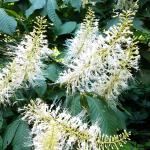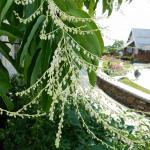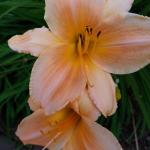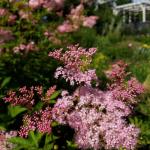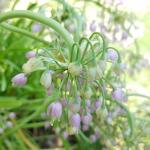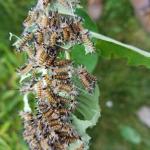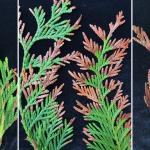UMass Extension's Landscape Message is an educational newsletter intended to inform and guide Massachusetts Green Industry professionals in the management of our collective landscape. Detailed reports from scouts and Extension specialists on growing conditions, pest activity, and cultural practices for the management of woody ornamentals, trees, and turf are regular features. The following issue has been updated to provide timely management information and the latest regional news and environmental data.
To read individual sections of the message, click on the section headings below to expand the content:
Scouting Information by Region
Environmental Data
The following data was collected on or about July 11, 2018. Total accumulated growing degree days (GDD) represent the heating units above a 50° F baseline temperature collected via our instruments for the 2018 calendar year. This information is intended for use as a guide for monitoring the developmental stages of pests in your location and planning management strategies accordingly.
|
MA Region/Location |
GDD |
Soil Temp |
Precipitation |
Time/Date of Readings |
||
|
2-Week Gain |
2018 Total |
Sun |
Shade |
|||
|
CAPE |
337.5 |
983 |
75 |
67 |
1.21 |
3:00 PM 7/11 |
|
SOUTHEAST |
n/a |
n/a |
n/a |
n/a |
n/a |
n/a |
|
NORTH SHORE |
347.5 |
1092.5 |
71 |
66 |
0.79 |
9:00 AM 7/11 |
|
EAST |
370 |
1225 |
74 |
68 |
1.60 |
2:00 PM 7/11 |
|
METRO |
317 |
1079.5 |
73 |
68 |
2.48 |
5:30 AM 7/11 |
|
CENTRAL |
318 |
1015 |
72 |
64 |
2.38 |
7:00 AM 7/11 |
|
PIONEER VALLEY |
356.2 |
1207.2 |
78 |
70 |
3.64 |
12:30 PM 7/11 |
|
BERKSHIRES |
320 |
1117 |
75 |
66 |
2.30 |
8:30 AM 7/11 |
|
AVERAGE |
338 |
1103 |
74 |
67 |
2.06 |
- |
|
n/a = information not available |
||||||
Drought conditions update: Viewing the map via the link below, dated July 12, shows Massachusetts is experiencing level D0 - 'Abnormally Dry' - in all areas of the following counties: Berkshire, Franklin, Hampshire, Hampden, Worcester, Middlesex, Essex and Norfolk. The northern 2/3rds of Bristol County and the northern 1/3rd of Plymouth County are now also 'Abnormally Dry'. The northwestern fifth of Franklin County is D1 - 'Moderate Drought'.
http://droughtmonitor.unl.edu/CurrentMap/StateDroughtMonitor.aspx?MA
Phenology
| Indicator Plants - Stages of Flowering (BEGIN, BEGIN/FULL, FULL, FULL/END, END) | ||||||||
|---|---|---|---|---|---|---|---|---|
| PLANT NAME (Botanic/Common) | CAPE | S.E. | N.S. | EAST | METRO W. | CENT. | P.V. | BERK. |
|
Buddleia davidii (Butterfly Bush) |
Begin |
* |
* |
Begin |
* |
* |
* |
Begin |
|
Oxydendron arboreum (Sourwood) |
Begin |
* |
Begin |
Begin |
Full |
Begin |
Begin |
* |
|
Tilia cordata (Littleleaf Linden) |
Full |
* |
Full |
Full |
Full |
Begin |
Full |
Full |
|
Campsis radicans (Trumpet Vine) |
Begin/Full |
* |
Full |
Full |
Full |
Full |
Full |
Full |
|
Koelreuteria paniculata (Goldenrain Tree) |
Full |
* |
Full/End |
Full |
* |
* |
* |
* |
|
Hydrangea macrophylla (Bigleaf Hydrangea) |
Begin/Full |
* |
Full |
Full |
Full |
Full |
Full |
* |
|
Hydrangea arborescens (Smooth Hydrangea) |
Begin/Full |
* |
Full |
Full |
Full |
Full |
Full |
Full |
|
Itea virginica (Virginia Sweetspire) |
Full/End |
* |
End |
End |
* |
Full |
Full/End |
Full/End |
|
Rhus typhina (Staghorn Sumac) |
Full |
* |
Full |
Full/End |
Full/End |
Full |
Full |
Full/End |
| * = no activity to report/information not available | ||||||||
Regional Notes
Cape Cod Region (Barnstable)
General Conditions: The average temperature over the last two weeks was 72° F with a high of 89° F on July 1 and a low of 51° F on July 8 & 9. Temperatures from June 29 – July 6 were higher than normal, with highs in the mid- to upper 80s each day. From July 6 until July 11, it was a little cooler, with lower humidity and nice for sleeping at night. 1.21 inches of precipitation fell during the period in two events. The rain fall on June 28 dropped over an inch in Barnstable, while other locations received up to 2.5 inches on that date. The other rain event on July 6, provided less than a quarter inch of precipitation. Topsoil moisture conditions are short, subsoil moisture conditions remain adequate.
Pests/Problems: Gypsy moth adults may be seen at this time in some areas; females don’t fly but the brown males do and are often seen fluttering around oak canopies. Other insects observed over the last week include Japanese beetle, Oriental beetle, wooly elm aphid (Eriosoma americanum) on American Elm, cottony camellia scale (Pulvinaria floccifera) on Hydrangea, azalea scale (Ericoccus azalea) on Rhododendron, Lecanium scale on oak, Viburnum leaf beetle damage (larvae are not present), lots of Hibiscus sawfly (Atomacera decepta) on hardy Hibiscus, columbine leafminer on columbine, turpentine beetle on pitch pine, 4 lined plant bug (Poecilocapus lineatus) damage on shasta daisy and various other perennials, black vine weevil damage on Rhododendron, and lacebug on azalea and Andromeda. Diseases visible over the last week include bacterial leaf spot on Rudbeckia fulgida ‘goldstrum’, cedar apple rust on crabapple, black spot on rose, downy mildew on ornamental hops, daylily leaf streak on daylily, and powdery mildew showing up on the usual plants (phlox, Monarda, lilac, peony). Some weeds in bloom are black swallowwort (Cynanchum nigrum), white clover (Tricolium repens), annual fleabane (Erigeron annuus), prostrate spurge (Euphorbia maculata), common groundsel (Senecio vulagris), and spotted knapweed (Centaurea maculosa).
Southeast Region (Hanson)
There is no report this week.
North Shore Region (Beverly)
General Conditions: This reporting period saw the end of June and beginning of July. The last two weeks have been very hot and humid. Day temperatures on most days were in the low to mid-90s. On only a few days were there recorded day temperatures in the mid-75s to mid-80s. Night temperatures were mostly in the mid-60s to low 70s. We gained 247.5 growing degree days during this period, bringing us to a total of 1092.5 growing degree days in Beverly since the beginning of the year. The last two weeks have been very dry except for a quick, passing storm on July 5th that brought some much needed precipitation. Approximately 0.79 inches of rainfall was received at Long Hill, Beverly during this reporting period. Woody plants seen in bloom include: oakleaf Hydrangea (Hydrangea quercifolia), big leaf Hydrangea (Hydrangea macrophylla), tree false Spirea (Sorbaria arborea), big leaf dogwood (Cornus macrophylla), Chinese chaste tree (Vitex chinensis), Goldenrain tree (Koelreuteria paniculata), Japanese Hydrangea vine (Schizophragma hydrangeoides), sourwood (Oxydendron arboreum) and lemon drop azalea (Rhododendron ‘Weston’s Lemon Drop’). Herbaceous plants seen in bloom include: summer flowering roses (Rosa spp.), Clematis vines (Clematis paniculata), spiderwort (Tradescantia spp.), water lily (Nymphaea odorata), hardy cranesbill (Geranium spp.), ox-eye daisy (Leucanthemum vulgare), bee balm (Monarda didyma), Hosta (Hosta spp.), Rudbeckia (Rudbeckia fulgida), daylilies (Hemerocallis spp.), Astilbes (Astilbe spp.), coneflower (Echinacea purpurea), milkweed (Asclepias syriaca) and yarrow (Achillea millefolium). Many annuals are also adding color in the landscape.
Pests/Problems: Magnolia scale (Neolecanium cornuparvum) was observed on saucer Magnolia. These are large scales with a white waxy covering. Small infestations can be removed any time of year by pruning out infested branches. Horticultural oils applied after the crawlers have emerged are effective in reducing the scale population. Another control option is to apply a systemic insecticide such as imidacloprid or dinotefuran as a basal soil drench. Make sure to follow the directions on the product label. Phyllosticta leaf blotch was observed on witchhazel (Hamamelis intermedia). Weeds continue to thrive in the landscape. Control weeds before they set seed. Poison ivy is also thriving so take caution when walking or working in the woods. Remember also that ticks and mosquitoes are still very active. Take measures to protect yourself while working outdoors, especially at dawn or at dusk.
East Region (Boston)
General Conditions: The last two weeks have been hot and humid with seven days above 90° F. The longest stretch was a three-day heat wave from the 3rd to 5th. We received relief on July 6 as thunderstorms moved through the area bringing seasonal conditions. High temperatures have ranged from 76° F to 96° F, averaging 88° F; low temperatures have ranged from 53° F to 73° F, averaging 65° F. Rain totaled 1.6 inches, most falling on June 28 and the remainder during a 2-hour span on July 6. We are at 1225 GGDs for the year, having accumulated 370 GDDs over the last two weeks. Plants in bloom include: Actaea racemosa (black cohosh), Albizia julibrissin (mimosa), Allium amethystinum ‘Red Mohican’ (flowering onion), Asclepias incarnata (swamp milkweed), A. tuberosa (butterflyweed), Astilbe spp. (Astilbe), Calycanthus raulstonii ‘Hartlage Wine’ (Raulston's allspice), Campsis grandiflora (Chinese trumpet creeper), Clematis hexapetala (Clematis), Clematis spp. (Clematis cultivars ‘Betty Corning’, ‘Emilia Plater’, ‘Marie Boisselot’, ‘Multi Blue’, and ‘Roguchi’), Echinacea purpurea (purple coneflower), Euonymus carnosus (fleshy-flowered spindletree), Hosta spp. (plaintain lily), Hydrangea bretschneideri (Mongolian Hydrangea), H. paniculata 'Bulk' Quick Fire® (panicle Hydrangea), H. quercifolia 'Snow Queen' (snow queen oakleaf Hydrangea), Hypericum kalmianum ‘Ames’ (St. John’s wort), Lavandula angustifolia (English lavender), Lonicera periclymenum 'Graham Thomas' (honeysuckle), Monarda fruticulosa (shrubby beebalm), Perovskia atriplicifolia (Russian sage), Platycodon grandiflorus (balloon flower), Rudbeckia fulgida (orange coneflower), R. hirta (black-eyed Susan), Saponaria officinalis (common soapwort), Sorbaria sorbifolia (false spiraea), and Yucca filamentosa (Adam's needle). Pollinators are highly active.
Pests/Problems: Soils are extremely dry. Recent plantings and drought susceptible species require supplemental irrigation. Mature species would also benefit from additional water. Undesired vegetation including crabgrass (Digitaria spp.) and yellow nutsedge (Cyperus esculentus) continue to thrive throughout the landscape. Phytolacca americana (pokeweed), Solanum dulcamara (bittersweet nightshade), and Urtica dioica (stinging nettle) are in bloom. Black swallowwort (Cynanchum louiseae) is in seed, but pods have yet to mature – now is the time to remove the pods or entire plants to reduce the spread. Adult male gypsy moths have emerged and were first seen flying on June 30; adult females have since emerged, mated and have begun laying egg masses on host trees. Adult Viburnum leaf beetles (Pyrrhalta viburni) have emerged and are actively feeding on Viburnum plants. High humidity has contributed to outbreaks of several fungal diseases, notably powdery mildew, black spot and anthracnose. Leaf miners are abundant this year on a wide range of plants.
Metro West (Acton)
General Conditions: It’s been a hot and humid couple of weeks! On six consecutive days, beginning on June 30th and ending on July 5th, the high temperatures were recorded in the 90s, with the highest temp of 96° F recorded on both July 1st and 3rd. For June, the monthly average precipitation is 3.93” and 4.69” of rain was recorded, but much of that fell fast and furiously in 2 rain events. For July, the monthly average precipitation is 4.07”. As of the 10th, a mere 0.77” of rain has been recorded. Much is in bloom in the landscape. In some stage of bloom at this time are the following woody plants: Aesculus parviflora (bottlebrush buckeye), Castanea mollissima (Chinese chestnut), Hydrangea arborescens (smooth Hydrangea), H. paniculata (panicle Hydrangea), H. quercifolia (oakleaf Hydrangea), Oxydendron arboreum (sourwood), Potentilla fruiticosa (Potentilla), Rhododendron viscosum (swamp azalea), Rhus typhina (staghorn sumac), Rosa rugosa (rose), R. 'Knockout' (the Knockout family of roses), Rosa spp. (rose), Sambucus canadensis (elderberry), Spirea japonica 'Alpina' (Daphne Spirea), Spirea spp. (bridal wreath), Stewartia psuedocamellia (Japanese Stewartia), and Tilia cordata (littleleaf linden). Woody vines in bloom are: Campsis radicans (trumpet vine) and Clematis spp. (Clematis). Contributing even more color and interest to the landscape are some flowering herbaceous plants including: Achillea millefoliumn (yarrow), Actaea matsumurae 'White Pearl' (bugbane), Alcea rosea (hollyhocks), Asclepias syriaca (common milkweed), A. tuberosa (butterfly weed), Astilbe spp. (false Spirea), Campanula persicifolia (peach-leafed bellflower), C. takesimana ‘Elizabeth’ (bellflower), Coreopsis spp. (tickseed), C. verticillata (threadleaf Coreopsis), Daucus carota (Queen Anne's lace), Echinacea purpurea (coneflower), Filipendula spp. (meadow sweet), Gaillardia aristata (Indian blanket flower), Geranium cantabrigiense 'Biokovo' and 'Cambridge' (hardy cranesbill), G. macrorrhizum (bigroot Geranium), G. sanguineum (cranesbill Geranium), G. ‘Johnson’s Blue’ (cranesbill), Hemerocallis fulva (orange daylily), H. 'Stella D'Oro', (daylily), H. spp. (daylily), Heuchera spp. (coral bells), Hosta spp. (plantain lily), Hyssopus oficinalis (Hyssop), Iris ensata ( Japanese Iris), Lavendula angustifolia (lavender), Liatris spicata (spike gayfeather), Leucanthemum spp. (shasta daisy), Lilium spp. (lily), Lychnis coronaria (rose campion), Lysimachia clethroides (gooseneck loosestrife), Monarda didyma (bee-balm), Nepeta spp. (ornamental catmint), Oenothera macrocarpa (Ozark sundrops), Perovskia atriplicifolia (Russian sage), Saponaria officinalis (soapwort), Silene latifolia (white campion), Stachys byzantina (lamb’s ear), Thymus praecox (thyme), Tradescantia spp. (spiderwort), Veronicastrum virginicum (Culver’s root), and Yucca filamentosa (Yucca).
Pests/Problems: Observed in the landscape these past two weeks were Cedar Apple Rust on Amelanchier spp. (serviceberry), and powdery mildew on Cornus florida (dogwood) and Syringa vulgaris (lilac). The lack of any substantial and steady rain continues to be a concern for our trees and shrubs in the landscape, especially compounded with the hot and humid weather and any other stresses such as winter or gypsy moth caterpillars, hemlock woolly adelgid, snow and ice removal applications, or previous year’s droughts. Signs of stress are apparent in the landscape including premature leaf wilt and drop.
Central Region (Boylston)
General Conditions: The dog days of summer have arrived in the last few weeks with last week being the hottest! A solid seven days in a row with temperatures in the 90’s, with the hottest recorded at 98° F. 2.38” of rain fell over the last few weeks, but the hot temperatures and the fact that most of it fell during downpour events made it less effective in the landscape. The heat and bright sun contributed to several days of plants showing signs of stress (such as a slight wilted appearance overall) and some leaf scorch in areas without irrigation. Even through the weather extremes, certain plants still looked great! Trees, shrubs and vines in bloom: bottlebrush buckeye (Aesculus parviflora), Knockout roses, smooth Hydrangea (Hydrangea arborescens), and panicle Hydrangea (H. paniculata). Rough-leaved Hydrangea (Hydrangea aspera) buds are beginning to expand after making it through intact this past winter for the first time in several years. Little leaf linden (Tilia cordata) is smelling amazing, with all of its dainty flowers perfuming the air. The sourwood tree (Oxydendrum arboreum) is just starting to open its bell-shaped white flowers and the two trees observed have double the amount of bloom compared to last year. Clematis ‘Polish Spirit’ is blooming heavily this year. Herbaceous perennials and bulbs in bloom: daylilies (Hemerocallis cultivars), queen of the prairie (Filipendula venusta ‘Robusta’), nodding onion (Allium cernuum), betony (Stachys officinalis ‘Hummelo’), and shasta daisy (Leucanthemum x superbum ‘Becky’).
Pests and diseases: The hatching of the gypsy moth caterpillars from pupae to adults was the item of greatest note over the last two weeks. The huge number of flying male moths are most visible, with the less noticeable flightless female moths also hatching and beginning to lay egg masses. Also noted were dogwood sawflies (Macremphytus spp.) in their early larval development. Later in their second instar phase, they develop a white waxy appearance in order to look similar to bird droppings, a disguise which protects them from being eaten by predators. Japanese Beetle adults were noted in the gardens along with several beetles having a white dot on the thorax, which is the egg site of the tachinid fly (Istocheta aldrichi). Hibiscus sawfly is still active as well. The milkweed tussock moth was observed hatching on swanflower (Gomphocarpus physocarpus), showy milkweed (Asclepias speciosa) and common milkweed (Asclepias syriaca).
Pioneer Valley Region (Amherst)
General Conditions: So much has happened since our last report, where to even begin? June closed out with a monster rain storm that in some locations dumped nearly a month’s worth of rain. After weeks of mostly dry and fair weather with below-average rainfall, we got a whopper of a storm that spanned two days (6/27 and 6/28). Accumulations from this multifaceted rain event ranged from 2–4” throughout the valley. Rain fell slowly as part of a large cell that swept through New England and as a deluge from isolated, fast-moving thunderstorms. Because so much rain fell in such a short period of time, washouts and erosion were issues. Downed trees and localized power outages were also reported. While some of the rain was lost as runoff, a significant volume did soak in and provided a deep watering to many landscape plants that were in need of water. Then, just as June ended and July started, summer really came roaring in with a six-day heat wave that gripped the whole region from 6/30 through 7/5. On Sunday 7/1, the Pioneer Valley experienced heat rarely felt in this region. Ambient air temperatures peaked near 100° F with unbearable dew points in the middle to upper 70s. Maximum heat index values reported by the National Weather Service reached 107° F in Springfield and Amherst, and 105° F in Greenfield. Despite a minor dip in the high temperatures, there was really no relief as daily heat advisories were enacted. During the six-day stretch, heat index values consistently hovered around ~105° F. Soil temperatures at the end of the heat wave on 7/5 came in at 81° F in the sun and 74° F in the shade at the monitoring location on the UMass campus. Temperatures have moderated a few degrees since the peak. Warm soils alone are not harmful to plants and many soil nutrients are more available at higher temperatures. But with the high heat and persistent winds in the valley there was significant water loss from transpiration. As plants seek to replace that lost water, soil drying can take place quickly within the rhizosphere. Rainfall since the beginning of July has been highly scattered throughout the valley. Some areas have received considerable amounts (e.g. >1”) from isolated thunderstorms while others have had nary a whiff of rain. Specifically, those storms took place on 7/3, 7/6 and 7/10. In Easthampton, less than 0.1” was recorded from those three events combined.
Pests/Problems: Oak spider mite injury is now visible on landscape trees. Scout for pale green to yellowish flecking on interior portions of leaves on interior canopy branches. There has been an impressive second flush of foliage observed on some landscape pin and red oaks in Hampshire County. This second flush, observed on trees with and without irrigation, is known as lammas growth and often indicates good growing conditions. The abundance of male gypsy moths awkwardly fluttering around has been quite the sight. While numerous towns in eastern Mass are familiar with this mid-summer occurrence, having endured serious defoliation from gypsy moth over the past several years, for many in the valley this is a new sight. Oriental and Japanese beetles are now common on garden vegetables, herbaceous annuals and perennials, and various trees and shrubs. Weeding ornamental beds is now a full-time job with a variety of weeds growing at a strong rate. Now is a good time to weed Oriental bittersweet seedlings, before they rapidly develop into full-blown choking hazards for trees and shrubs. If you are battling established bittersweet vines, continue the fight! Cutting vines near the soil line and applying glyphosate to the cross-sectional surface will kill the roots and eliminate resprouting. If you suspect Verticillium wilt on maple, tulip poplar or smoketree, among other landscape trees, use a knife to scrape away the bark to determine if vascular staining is present in declining branches. The staining can appear from green to olive-green to brown and may be present deep in the xylem tissue. Cutting small, cross-sectional disks can be helpful when looking for “pitting” (staining in older xylem tissue). Heat scorch has been observed on a variety of landscape plants. Brown to almost blackened necrotic blotches develop on interveinal portions of the leaf surface, usually on the interior close to the base of the leaf. Wood-rotting fungi are now starting to appear on the landscape. The northern tooth fungus (Climacodon septentrionalis) was observed on a Norway maple while Fomitopsis spraguei was found growing from the base of a pin oak. Continue to scout for the presence of annual, biennial and perennial fruiting bodies growing near or on hardwoods and conifers, as this is often the only indication they are harboring internal decay.
Berkshire Region (Great Barrington)
General Conditions: After heavy rains amounting to 1.92 inches fell on June 27 and 28, the prevailing weather could be characterized as extremely hot and dry. The hot weather prompted rapid drying of soil, creating drought conditions throughout the county. A brief shower on July 5 dropped 0.36 inches of rain but it did little to moisten very dry soils. High temperatures in the 90s occurred each day from June 30 through July 5 at this monitoring station in Great Barrington. Temperatures during that time reached as high as 95° F. The National Weather Service at Pittsfield Airport recorded maximum temperature records were set or tied during that period. On July 10, temperatures at the Great Barrington site reached 93° F. These high temperatures set off a rush to stores for fans, air conditioners, and even refrigerators, according to one hardware outlet. The latter due to compressors burning out as they worked hard to sustain cold temperatures. Though total precipitation for the year is only an inch below normal, the occurrence of rainfall since late spring has been infrequent. As a result, soils are very dry. Growth of crop plants and turfgrass is very slow. The heat has also shortened the bloom phase of many flowering trees and shrubs.
Pests/Problems: Japanese beetles have appeared since the last landscape message and are abundant, leaving the foliage on a wide variety of trees, shrubs, and herbaceous plants skeletonized. Fall webworm has made an appearance and is being reported most frequently on the shoots of Hydrangeas. The feeding habit of Magnolia scale is now causing dripping of honeydew on foliage of Magnolias and on anything parked beneath the trees. The honeydew-covered leaves typically are blackened by sooty mold. Another sap-sucking, sooty mold-creating pest is the aphid. Aphids are presently feeding on many plant species including tulip trees (Liriodendron tulipifera). An unusual aphid first seen by this observer last year is the bow-legged fir aphid (Cinara spp.). It has again appeared on a Korean fir. Leaf blotches caused by leaf miners can be found on many plant species but in most cases the damage is done as the leaf-feeding larvae have since pupated and moved on as adults. Some of the most prominent leaf damage observed recently was to a golden locust (Robinia pseudoacacia). Large blotches caused by the locust leaf miner (Odontota dorsalis) could be seen on almost all the leaves of the tree. Other pests found lately include: spruce spider mite, two-spotted spider mite, imported willow leaf beetle (adult) and adult Asiatic garden beetles. The latter pest is often found when weeding or tilling soil. The adults remain in the soil during the day but emerge at night to feed on foliage and flowers. Powdery mildew on ninebark and lilacs, black spot of roses, apple scab and cedar apple rust of crabapples are the most common diseases observed of late. Weir’s spruce cushion rust, caused by the fungus Chrysomyxa weirii, was found to have spread from last season’s needles onto the current season’s needles. Some leaf scorch has occurred on a few small trees. The darkening of tissue between the veins of leaves is a typical symptom of leaf scorch. Particular attention to watering newly planted trees and shrubs may help prevent premature leaf drop.
Regional Scouting Credits
- CAPE COD REGION - Russell Norton, Horticulture and Agriculture Educator with Cape Cod Cooperative Extension, reporting from Barnstable.
- SOUTHEAST REGION -
- NORTH SHORE REGION - Geoffrey Njue, Green Industry Specialist, UMass Extension, reporting from the Long Hill Reservation, Beverly.
- EAST REGION - Kit Ganshaw & Sue Pfeiffer, Horticulturists, reporting from the Arnold Arboretum, Jamaica Plain.
- METRO WEST REGION - Julie Coop, Forester, Massachusetts Department of Conservation & Recreation, reporting from Acton.
- CENTRAL REGION - Dawn Davies, Interim Horticulture Manager, reporting from Tower Hill Botanic Garden, Boylston.
- PIONEER VALLEY REGION - Nick Brazee, Plant Pathologist, UMass Extension Plant Diagnostic Lab, reporting from UMass Amherst.
- BERKSHIRE REGION - Ron Kujawski, Horticultural Consultant, reporting from Great Barrington.
Woody Ornamentals
Diseases
Recent pests and pathogens of interest seen in the UMass Extension Plant Diagnostic Lab:
Dutch elm disease, caused by Ophiostoma novo-ulmi, of Princeton elm (Ulmus americana 'Princeton'). Tree is approximately 6-7″ in diameter and was directly next to a 32” dbh American elm (U. americana) that died of DED in 2017 and was recently removed. In late June, approximately 20% of the canopy exhibited wilted, pale green leaves. One week later, nearly 50% of the canopy was symptomatic, illustrating how quickly symptom development can intensify. Root grafting is suspected between the two trees and may have served as the source of the infection for the Princeton elm. The tree was injected with propiconazole after symptom onset in June but it was likely too late to save the tree.
Phyllosticta needle blight, caused by Phyllosticta thujae, on western red cedar (Thuja plicata). Four trees that are 10-years-old and have been present at the site for three years. Drip irrigation is provided and soils are characterized as sandy and moderately well-drained. Three of the four trees have significant needle browning in the canopy, first developing as a tip blight and then advancing to entire shoots (see image). Phyllosticta needle blight is common and sometimes very destructive on Thuja and Chamaecyparis, among other landscape conifers in the Cupressaceae.
Edema of umbrella pine (Sciadopitys verticillata) caused by overwatering. Tree is less than 10-years-old and has been present at the site for approximately three to four years. This year, the canopy exhibited pale older needles and a general “thin” appearance. Submitted needles were pale green to yellow with brown-colored, callus tissue on the underside. Edema is most common on landscape yews but many conifers can be subject to the condition.
Needle blight of Austrian pine (Pinus nigra) caused by Septoriodes strobi. Tree is 30-years-old and has been present at the site for almost 25 years. The tree’s canopy is very thin with many blighted tips. The setting includes partial shade from an adjacent maple and good loamy soil. Septorioides is a newly described fungal pathogen that is associated with needle blight of eastern white pine in the northeast. This is the first hard pine sample the lab has received with Septorioides. However, given that many pine needle blight fungi attack both hard and soft pines, its occurrence is not overly surprising.
Needle browning and dieback of white fir (Abies concolor) caused by transplant shock. The tree is roughly seven-years-old and has been present at the site for only one year. The needle browning is present in both the upper and lower canopy. The tree was planted in partial shade and receives supplemental water through drip irrigation. Submitted shoots were wilted and there was no evidence of insect feeding or attack from a disease-causing pathogen. Among landscape conifers, white fir can be difficult to transplant at times.
Foliar anthracnose of Sky Pencil holly (Ilex crenata 'Sky Pencil') caused by Colletotrichum. The shrub is seven-years-old and has been present at the site for five years. The site is characterized by clay soils and partial shade with supplemental water provided by overhead irrigation. Submitted leaves exhibited browning leaf margins with the disease spreading from tip to base. Submitter noted premature leaf shedding and branch dieback in the canopy. Overhead watering likely contributed to disease development.
Insects
Woody ornamental insect and non-insect arthropod pests to consider, a selected few:


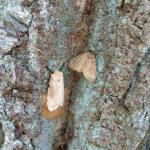
 Gypsy Moth:(Lymantria dispar) host plants include but are certainly not limited to oak (favored), maple, birch, poplar, and many others. Gypsy moth caterpillar feeding for 2018 is officially over! Pupation has occurred, and many across the state are noticing gypsy moth adult male flight activity. Adult moths were reported to UMass Extension by landscape practitioners and homeowners in Amherst and Millis, MA on 7/2/18, Holliston, MA on 7/3/18, Natick, MA on 7/4/18, and many male moths (estimated hundreds) could be seen flying outside of French Hall on the UMass Amherst campus on 7/5/18. On 7/10/18 at a location in Amherst, MA, gypsy moth males are still fluttering around, mating with females, and many female gypsy moths are seen laying eggs on tree trunks and branches.
Gypsy Moth:(Lymantria dispar) host plants include but are certainly not limited to oak (favored), maple, birch, poplar, and many others. Gypsy moth caterpillar feeding for 2018 is officially over! Pupation has occurred, and many across the state are noticing gypsy moth adult male flight activity. Adult moths were reported to UMass Extension by landscape practitioners and homeowners in Amherst and Millis, MA on 7/2/18, Holliston, MA on 7/3/18, Natick, MA on 7/4/18, and many male moths (estimated hundreds) could be seen flying outside of French Hall on the UMass Amherst campus on 7/5/18. On 7/10/18 at a location in Amherst, MA, gypsy moth males are still fluttering around, mating with females, and many female gypsy moths are seen laying eggs on tree trunks and branches.
Adult male gypsy moths are generally brown in color with feathered antennae and can fly. They can often be seen flying across the landscape with a jumpy, almost erratic pattern. The males are searching for flightless females with which they will mate. The males can sense pheromones (sexually attractive chemicals) released by the females and they use these pheromone signals to locate a mate. Females, although they have wings, cannot fly and are white in color with thread-like, black antennae. Female moths may be seen at this time resting on tree trunks and branches and actively laying the spongey, tan-brown colored egg masses, which can contain 500-1000 eggs. These egg masses will overwinter on tree trunks, branches, picnic tables and other outdoor furniture, the sides of buildings, and any other flat surface the female moth lays them on and provide the gypsy moth population for 2019. For activity in areas closer to you, please see the Regional Reports above.
On average, when thinking about the entire state of Massachusetts as a whole, the 2018 gypsy moth population did decrease when compared to the population in 2017. While MA experienced over 923,000 acres of defoliation in 2017, the hope is that this number will be much less in 2018. The MA Department of Conservation and Recreation is currently conducting their aerial survey of the state, and will have the estimated 2018 acreage available in the near future. That being said, this experience of a decrease in the gypsy moth population did not hold true for every individual community and neighborhood across MA in 2018. UMass Extension has received many reports of communities dealing with what they describe as just as bad, if not worse, gypsy moth caterpillar populations this year. It certainly seems that this is the case for areas in Amherst and Belchertown, MA (where female gypsy moths are now healthy and laying eggs and previously much defoliation occurred due to the caterpillars).
We can hope that the gypsy moth population size will continue to trend downward, but in certain locations in MA – noticeable populations could still exist in 2019. This seems true for Amherst and Belchertown, where (unfortunately) it does not look like Entomophaga maimaiga (the caterpillar killing fungus) had as large of an impact on the gypsy moth population in 2018 as it did in 2017. In the coming weeks, it will be important to monitor the adult females and get a sense of how many total egg masses are being laid in your area, or on individual properties, to aid in management decisions for next season.
A note about gypsy moth management: at this time, it is not recommended to manage the adult moths, as feeding has stopped for the season. Homeowners frequently ask about scraping egg masses from trees, to help decrease next year’s population. This can be done on individual properties, when egg masses can be safely reached, but this is time consuming and undoubtedly, plenty of egg masses (particularly those high up in the canopy) will be missed. If you decide to scrape off egg masses, do so into a can of soapy water (do not just brush them to the ground, as the eggs may still survive). Use a gloved hand, or a soft brush to remove the egg mass from the bark or other surface. Avoid any actions that remove bark from host plants, while attempting to remove egg masses. Others ask about using horticultural oils on the egg masses. This may only be as effective as the coverage of the horticultural oil on the eggs themselves is thorough. Each egg must be thoroughly coated, which again presents problems on egg masses located high up in trees and even eggs further away from the top of an individual mass. Do not coat gypsy moth egg masses with anything that is not explicitly labelled for such a use (ex. WD-40 is not the answer). The best action at this time may be to scout your property and get an idea of how many egg masses are being laid by female moths. If there are many egg masses, consider speaking with a MA licensed pesticide applicator and professional about reduced risk options for managing the caterpillars when they hatch from the eggs next spring.
- Asian Longhorned Beetle: (Anoplophora glabripennis, ALB) Look for signs of an ALB infestation which include perfectly round exit holes (about the size of a dime), shallow oval or round scars in the bark where a female has chewed an egg site, or sawdust-like frass (excrement) on the ground nearby host trees or caught in between branches. Be advised that other, native insects may create perfectly round exit holes or sawdust-like frass, which can be confused with signs of ALB activity. Adult insects may be seen beginning in July in the regulated area in Massachusetts.
The regulated area for Asian longhorned beetle is 110 miles2 encompassing Worcester, Shrewsbury, Boylston, West Boylston, and parts of Holden and Auburn. If you believe you have seen damage caused by this insect, such as exit holes or egg sites, on susceptible host trees like maple, or believe you have captured or taken a photo of an adult insect, please call the Asian Longhorned Beetle Eradication Program office in Worcester, MA at 508-852-8090 or toll free at 1-866-702-9938.
To report an Asian longhorned beetle find online or compare it to common insect look-alikes, visit: http://massnrc.org/pests/albreport.aspx or https://www.aphis.usda.gov/pests-diseases/alb/report .
- Asiatic Garden Beetle: Maladera castanea adults are active and are typically most abundant in July and August. These rusty-red colored beetles are bullet-shaped and active at night. They are often attracted to porch lights. They feed on a number of ornamental plants, defoliating leaves by giving the edges a ragged appearance and also feeding on blossoms. Butterfly bush, rose, dahlia, aster, and chrysanthemum can be favored hosts. When levels of damage reach a management threshold, pyrethroid- based insecticides may be necessary. Read and follow label instructions and avoid harming non-target organisms. Certain neem oil products are also labelled for use against adult beetles. Observe label instructions to minimize the potential for leaf injury.
- Deer Tick/Blacklegged Tick: Ixodes scapularis adult females, following a blood meal, can lay a single egg mass (up to 1500 – 2000 eggs) in mid-late May, then the female deer tick perishes. Larvae emerge from the eggs later in the summer. Larvae are tiny and six-legged. Prior to feeding, they are not known to be able to transmit disease. After feeding, the larvae drop from their host and molt, re-emerging the following spring as nymphs. Nymphs (from last year’s overwintering cohort) are active from May-August. Nymphs are eight-legged and about the size of the head of a pin. These tiny nymphs typically attach to small mammal hosts; however, they will readily feed on people and pets. Nymphs are capable of carrying Lyme disease, human Babesiosis, human Anaplasmosis, and deer tick virus. For images of all deer tick life stages, along with an outline of the diseases they carry, visit: http://www.tickencounter.org/tick_identification/deer_tick .
Anyone working in the yard and garden should be aware that there is the potential to encounter deer ticks. Preventative activities, such as daily tick checks, wearing appropriate clothing, and permethrin treatments for clothing (according to label instructions) can aid in reducing the risk that a tick will become attached to your body. If a tick cannot attach and feed, it will not transmit disease. For more information about personal protective measures, visit: http://www.tickencounter.org/prevention/protect_yourself .
Have you just removed an attached tick from yourself or a loved one with a pair of tweezers? If so, consider sending the tick to the UMass Laboratory of Medical Zoology to be tested for disease causing pathogens. To submit a tick to be tested, visit: https://www.tickreport.com/ and click on the red “Test A Tick” button. Results are typically available within 3 business days, or less. By the time you make an appointment with your physician following the tick attachment, you may have the results back from TickReport to bring to your physician to aid in a conversation about risk.
The UMass Laboratory of Medical Zoology does not give medical advice, nor are the results of their tests diagnostic of human disease. Transmission of a pathogen from the tick to you is dependent upon how long the tick had been feeding, and each pathogen has its own transmission time. TickReport is an excellent measure of exposure risk for the tick (or ticks) that you send in to be tested. Feel free to print out and share your TickReport with your healthcare provider.
You can also follow TickReport on Twitter @TickReport for timely updates from the Laboratory of Medical Zoology, including the latest tick and tick-borne disease related research.
- Dogwood Spittlebug: (Clastoptera proteus) occurs in New England, wherever dogwoods are grown. This species may also feed on Vaccinium and Aesculus. Adults and nymphs of this hemipteran are found feeding on the same host. The adult insect is called a froghopper. Eggs are laid in punctures created by adults in the bark of outer twigs. Each puncture may contain 1-3 eggs. Eggs overwinter and nymphs emerge in June and early July. A sugary, frothy substance is created by the feeding nymphs, as they secrete excess sap as they feed, causing it to froth by pumping air into this excrement. They can be completely hidden in this “spittle”. Dogwood spittlebug activity was seen in Amherst, MA on 6/20/2018. The impact these insects have is largely aesthetic, and management is rarely recommended.
- Emerald Ash Borer: (Agrilus planipennis, EAB) This wood-boring beetle readily attacks ash (Fraxinus spp.) including white, green, and black ash and has also been found developing in white fringe tree (Chionanthus virginicus) and most recently, has been reported in cultivated olive (Olea europaea). Signs of an EAB infested tree may include D-shaped exit holes in the bark (from adult emergence), “blonding” or lighter coloration of the ash bark from woodpecker feeding (chipping away of the bark as they search for larvae beneath), and serpentine galleries visible through splits in the bark from larval feeding beneath. Positive identification of an EAB-infested tree may not be possible with these signs individually on their own.
For further information about this insect, please visit: https://ag.umass.edu/fact-sheets/emerald-ash-borer . If you believe you have located EAB-infested ash trees, particularly in an area of Massachusetts not identified on the map provided, please report here: http://massnrc.org/pests/pestreports.htm .
- Euonymus Caterpillar: Yponomeuta cagnagella is of European origin and widespread in distribution throughout Europe. It was first reported in North America in Ontario in 1967. On 6/11/2018, a common spindle tree (Euonymus europaeus) on the UMass Amherst campus was found with a heavy infestation of euonymus caterpillars. The infested tree is approximately 3.1 miles away from the initial area in Amherst, MA reported on for this insect. On 6/11/18 in this location, the majority of caterpillars were found to be spinning white cocoons within which they pupate. Large sections of this individual tree are covered in webbing and cocoons. Webbing falling from the tree covers the turf below, and some caterpillars are pupating in clumps of webbed turf. By 6/20/2018, all of the caterpillars at this location have pupated and are present in their white cocoons. A tiny percentage of the small adult moths have emerged as of 6/20/18 at this location. Moths are white with black spots.
The euonymus caterpillars (larvae) feed in groups and envelop the foliage of the host plant in webs as they feed. Hosts include: Euonymus europaeus (tree form), E. kiautschovicus, E. alatus, and E. japonicus. Mature caterpillars are just under an inch in length, creamy yellow-gray in color with black spots and a black head capsule. By late June, these larvae pupate in white, oval-shaped cocoons which are typically oriented together vertically either on host plants or non-hosts in the area. Cocoons can be found in cracks and crevices, or webbed together leaves. The adult moth emerges in late June in most locations. The adult female secretes a gummy substance over her eggs which will harden, making them even more difficult to see. Eggs hatch by mid-August, at which time the tiny larvae prepare to overwinter beneath their eggshell-like covering. These larvae are inactive until the following year, when caterpillars group together to feed on newly emerging leaves, creating a mess of webs as they feed. There is one generation per year. Plants may be partially or entirely defoliated.
- Fall Webworm: Hyphantria cunea is native to North America and Mexico. It is now considered a world-wide pest, as it has spread throughout much of Europe and Asia. (For example, it was introduced accidentally into Hungary from North America in the 1940’s.) Hosts include nearly all shade, fruit, and ornamental trees except conifers. In the USA, at least 88 species of trees are hosts for these insects, while in Europe at least 230 species are impacted. In the past history of this pest, it was once thought that the fall webworm was a two-species complex. It is now thought that H. cunea has two color morphs – one black headed and one red headed. These two color forms differ not only in the coloration of the caterpillars and the adults, but also in their behaviors. Caterpillars may go through at least 11 molts, each stage occurring within a silken web they produce over the host. When alarmed, all caterpillars in the group will move in unison in jerking motions that may be a mechanism for self-defense. Depending upon the location and climate, 1-4 generations of fall webworm can occur per year. Fall webworm adult moths lay eggs on the underside of the leaves of host plants in the spring. These eggs hatch in late June or July depending on climate. Fall webworm caterpillars were reported for 2018 previously in the Pioneer Valley Region report and expanding webs were seen the week of 7/4/18 in Chesterfield, MA. Young larvae feed together in groups on the undersides of leaves, first skeletonizing the leaf and then enveloping other leaves and eventually entire branches within their webs. Webs are typically found on the terminal ends of branches. All caterpillar activity occurs within this tent, which becomes filled with leaf fragments, cast skins, and frass. Fully grown larvae then wander from the webs and pupate in protected areas such as the leaf litter where they will remain for the winter. Adult fall webworm moths emerge the following spring/early summer to start the cycle over again. 50+ species of parasites and 36+ species of predators are known to attack fall webworm in North America. Fall webworms typically do not cause extensive damage to their hosts. Nests may be an aesthetic issue for some. If in reach, small fall webworm webs may be pruned out of trees and shrubs and destroyed. Do not set fire to H. cunea webs when they are still attached to the host plant.
- Imported Willow Leaf Beetle: (Plagiodera versicolora) by 6/27/18, larvae have pupated at a location in Chesterfield, MA and adults are again present. The adults will eventually locate sheltered areas in which they will overwinter. Most plants can tolerate the feeding from this insect, and foliage will appear brown. Repeated yearly feeding can be an issue, in which case management of the young larvae may be necessary. Take care with treatment in areas near water.

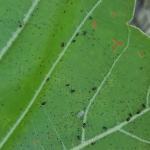 Lace Bugs: Corythucha spp. and Stephanitis spp. lace bugs are active. Corythucha spp. utilize many hosts such as hawthorn, cotoneaster, Amelanchier, quince, Pyracantha, various oaks, birch, maple, mountain ash, sycamore, hackberry, elm, walnut, butternut, basswood, etc. Corythucha spp. adult lace bugs were seen feeding on bur oak on 6/13/2018 in Amherst, MA. Many adult lace bugs were seen on leaf undersides, along with groups of tiny, black eggs. These groups of lace bug eggs were seen on nearly every leaf examined within reach on this tree. Egg are so small, they may look likefungal spores without magnification. Corythucha spp. adult and nymphal lace bugs were seen feeding on sycamore on 7/9/18 in Amherst, MA. The species that is most commonly found on sycamore is Corythucha ciliata, or the sycamore lace bug. This insect is found throughout the United States and parts of Canada. This lace bug, like most, can be found feeding on leaf undersides, initially causing a white stippling that can sometimes progress to chlorotic or bronzed foliage and may (when severe) lead to premature leaf drop.
Lace Bugs: Corythucha spp. and Stephanitis spp. lace bugs are active. Corythucha spp. utilize many hosts such as hawthorn, cotoneaster, Amelanchier, quince, Pyracantha, various oaks, birch, maple, mountain ash, sycamore, hackberry, elm, walnut, butternut, basswood, etc. Corythucha spp. adult lace bugs were seen feeding on bur oak on 6/13/2018 in Amherst, MA. Many adult lace bugs were seen on leaf undersides, along with groups of tiny, black eggs. These groups of lace bug eggs were seen on nearly every leaf examined within reach on this tree. Egg are so small, they may look likefungal spores without magnification. Corythucha spp. adult and nymphal lace bugs were seen feeding on sycamore on 7/9/18 in Amherst, MA. The species that is most commonly found on sycamore is Corythucha ciliata, or the sycamore lace bug. This insect is found throughout the United States and parts of Canada. This lace bug, like most, can be found feeding on leaf undersides, initially causing a white stippling that can sometimes progress to chlorotic or bronzed foliage and may (when severe) lead to premature leaf drop.
Stephanitis spp. lace bugs are active. Yellow stippling on leaf surfaces, black colored tar-like spots on leaf undersides, and lace bug nymphs (immatures) were seen on leaf undersides on 5/30/18, 6/7/18, and 6/13/18 in Amherst, MA on Rhododendron spp. foliage. Stephanitis spp. lacebugs such as S. pyriodes can cause severe injury to azalea foliage. S. rhododendri can be common on Rhododendron and mountain laurel. S. takeyai has been found developing on Japanese Andromeda, Leucothoe, Styrax, and willow. Stephanitis spp. lace bug activity should be monitored through September. Before populations become too large, treat with a summer rate horticultural oil spray as needed. Be sure to target the undersides of the foliage in order to get proper coverage of the insects. Fall or early spring soil treatment with imidacloprid has been effective, but be aware of the implications this may have on pollinators attracted to these flowering plants when making management decisions. Certain azalea and Andromeda cultivars may be less preferred by lace bugs.
- Lily Leaf Beetle: (Lilioceris lilii) Susceptible hosts include Lilium spp. (Turk’s cap, tiger, Easter, Asiatic, and Oriental lilies) and Fritillaria spp. (Note: daylilies are not hosts.) Typically, in May, mating will occur and each female will begin to lay 250-450 eggs in neat rows on the underside of the foliage. In Amherst, MA, orange lily leaf beetle eggs were observed on the underside of host plant foliage on 5/16/2018 and some of these eggs hatched by 5/23/18. Frass-covered larvae were observed feeding on 5/23/18, 5/30/18, 6/7/18, 6/13/18, and 6/27/18 in Amherst, MA. Larvae are growing ever larger and eating entire leaves. Younger groups of eggs are hatching with still tiny larvae starting to feed by skeletonizing the leaf in groups. Where adults and larvae are seen, they can be removed from host plants with a gloved hand where practical.
- Spotted Lanternfly: (Lycorma delicatula, SLF) is not known to occur in Massachusetts. This insect is a member of the Order Hemiptera (true bugs, cicadas, hoppers, aphids, and others) and the Family Fulgoridae, also known as planthoppers. This insect is a non-native species first detected in the United States in Berks County, Pennsylvania and confirmed on September 22, 2014. Until November 2017, this invasive insect was only known to Pennsylvania. It has now been reported from Delaware (November 20, 2017), New York (November 29, 2017), and most recently in Virginia (January 10, 2018). The Delaware Department of Agriculture announced the finding of a single female spotted lanternfly in New Castle County in the Wilmington, Delaware area. At this time, officials in Delaware note that it is unclear if this individual was an accidental hitchhiker, or evidence of an established population in the state. For more information about the find in Delaware, visit: https://news.delaware.gov/2017/11/20/spotted-lanternfly-confirmed-delaware/ . The New York State Department of Agriculture and Markets reported on November 29, 2017 the finding of a single dead individual spotted lanternfly in the state from earlier in the month. A single dead specimen was confirmed at a facility in Delaware County, New York, which is located south-west of Albany. The NYS Dept. of Agriculture and Markets states that this dead individual may have come in on an interstate shipment. For more information about the find in New York, visit: https://www.agriculture.ny.gov/AD/release.asp?ReleaseID=3637 . Most recently, Virginia Cooperative Extension announced the finding of a spotted lanternfly population in Frederick County, Virginia, on January 10, 2018. It was noted that at the location in Virginia, numerous adult lanternflies and egg masses were discovered, in addition to more at another site approximately 400 yards away. For more information about the find in Virginia, visit: https://ext.vt.edu/agriculture/commercial-horticulture/spotted-lanternfly.html .
The spotted lanternfly is considered native to China, India, and Vietnam. It has been introduced as a non-native insect to South Korea and Japan, prior to its detection in the United States. In South Korea, it is considered invasive and a pest of grapes and peaches. The spotted lanternfly has been reported from over 70 species of plants, including the following: tree of heaven (Ailanthus altissima) (preferred host), apple (Malus spp.), plum, cherry, peach, apricot (Prunus spp.), grape (Vitis spp.), pine (Pinus spp.), pignut hickory (Carya glabra), Sassafras (Sassafras albidum), serviceberry (Amelanchier spp.), slippery elm (Ulmus rubra), tulip poplar (Liriodendron tulipifera), white ash (Fraxinus americana), willow (Salix spp.), American beech (Fagus grandifolia), American linden (Tilia americana), American sycamore (Platanus occidentalis), big-toothed aspen (Populus grandidentata), black birch (Betula lenta), black cherry (Prunus serotina), black gum (Nyssa sylvatica), black walnut (Juglans nigra), dogwood (Cornus spp.), Japanese snowbell (Styrax japonicus), maple (Acer spp.), oak (Quercus spp.), and paper birch (Betula papyrifera).
The adults and immatures of this species damage host plants by feeding on sap from stems, leaves, and the trunks of trees. In the springtime in Pennsylvania (late April - mid-May) nymphs (immatures) are found on smaller plants and vines and new growth of trees and shrubs. Third and fourth instar nymphs migrate to the tree of heaven and are observed feeding on trunks and branches. Trees may be found with sap weeping from the wounds caused by the insect’s feeding. The sugary secretions (excrement) created by this insect may coat the host plant, later leading to the growth of sooty mold. Insects such as wasps, hornets, bees, and ants may also be attracted to the sugary waste created by the lanternflies, or sap weeping from open wounds in the host plant. Host plants have been described as giving off a fermented odor when this insect is present.
Adults are present by the middle of July in Pennsylvania and begin laying eggs by late September and continue laying eggs through late November and even early December in that state. Adults may be found on the trunks of trees such as the tree of heaven or other host plants growing in close proximity to them. Egg masses of this insect are gray in color and look similar to gypsy moth egg masses.
Host plants, bricks, stone, lawn furniture, recreational vehicles, and other smooth surfaces can be inspected for egg masses. Egg masses laid on outdoor residential items such as those listed above may pose the greatest threat for spreading this insect via human aided movement.
For more information about the spotted lanternfly, visit this fact sheet: https://ag.umass.edu/landscape/fact-sheets/spotted-lanternfly .
- Taxus Mealybug: Dysmicoccus wistariae was spotted on Taxus in Amherst on 5/23/18, 5/30/18, 6/7/18, 6/13/18, and again on 6/27/18. This insect will produce honeydew leading to sooty mold growth, yellowing of needles, and sparsely foliated plants. Eventual dieback may be possible. This species is commonly associated with Taxus in New England, but can be occasionally found on dogwood, Rhododendron, Prunus spp., maple, Andromeda, and crabapple. These mealybugs are found on stems and branches and particularly like to congregate at branch crotches. Management may be targeted between 246-618 GDD’s. Horticultural oil and neem oil may be used.

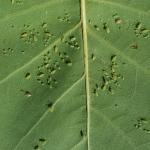 Tuliptree Aphid: Illinoia liriodendri is a species of aphid associated with the tuliptree wherever it is grown. (They may at times also feed on magnolia, according to reports.) The tuliptree aphid was seen feeding on the undersides of leaves on 7/9/18 in Amherst, MA. Depending upon local temperatures, these aphids may be present from mid-June through early fall. Large populations can develop by late summer. Some leaves, especially those in the outer canopy, may brown and drop from infested trees prematurely. The most significant impact these aphids can have is typically the resulting honeydew, or sugary excrement, which may be present in excessive amounts and coat leaves and branches, leading to sooty mold growth. This honeydew may also make a mess of anything beneath the tree. Wingless adults are approximately 1/8 inch in length, oval, and can range in color from pale green to yellow. There are several generations per year. This is a native insect. If management is deemed necessary, select options that will preserve natural enemies, as ladybeetles and other beneficial insects are often associated with the tuliptree aphid.
Tuliptree Aphid: Illinoia liriodendri is a species of aphid associated with the tuliptree wherever it is grown. (They may at times also feed on magnolia, according to reports.) The tuliptree aphid was seen feeding on the undersides of leaves on 7/9/18 in Amherst, MA. Depending upon local temperatures, these aphids may be present from mid-June through early fall. Large populations can develop by late summer. Some leaves, especially those in the outer canopy, may brown and drop from infested trees prematurely. The most significant impact these aphids can have is typically the resulting honeydew, or sugary excrement, which may be present in excessive amounts and coat leaves and branches, leading to sooty mold growth. This honeydew may also make a mess of anything beneath the tree. Wingless adults are approximately 1/8 inch in length, oval, and can range in color from pale green to yellow. There are several generations per year. This is a native insect. If management is deemed necessary, select options that will preserve natural enemies, as ladybeetles and other beneficial insects are often associated with the tuliptree aphid.
- Twolined Chestnut Borer: Agrilus bilineatus is a native jewel beetle (also known as a flatheaded borer) in the Family Buprestidae. This insect is in the same genus as the invasive emerald ash borer. The twolined chestnut borer is native to Massachusetts, much of New England, and the eastern United States. This species has one generation per year and adults are typically active from April – August, depending upon location and temperature. Adults will conduct some maturation feeding on oak prior to mating. Females will lay clusters of tiny eggs in the cracks and crevices of bark. Larvae hatch from the eggs in 1-2 weeks and burrow through the bark into the cambium, where they feed in a similar manner to the emerald ash borer, creating meandering galleries as they feed. (The galleries of the twolined chestnut borer can be straight in very stressed trees.) Larvae typically mature August through October and burrow to the outer bark where they create a chamber in which they overwinter. Pupation occurs the following spring and adults emerge through D-shaped exit holes that are approximately 1/5 inch wide. In the northern extent of this insect’s range, they can take 2 years to complete their life cycle. Larvae of this insect have been recorded from eastern white oak, common post oak, burr oak, scarlet oak, northern red oak, and eastern black oak. Adults have been recorded on fir and pin oak. In the case of an individual adult twolined chestnut borer observed on 6/7/18 in Amherst, MA, it was lingering on an elm leaf. There are oaks nearby, so this could just be happenstance as the insect searches for a suitable host.These insects are attracted to stressed host plants and typically become a secondary factor in the decline of the tree.
- Two-Spotted Spider Mite: Tetranychus urticae is a “warm-season” mite that loves hot and dry weather, which may favor the quick reproduction and build-up of this pest. Management should seek to preserve beneficial predatory mites. Monitor susceptible hosts (elm, maple, redbud, ash, black locust, tuliptree, and many deciduous shrubs) for increasing numbers of these mites until mid-August. Mites will be found on the undersides of leaves and cause stippling of the foliage.
- Viburnum Leaf Beetle: Pyrrhalta viburni is a beetle in the family Chrysomelidae that is native to Europe, but was found in Massachusetts in 2004. Viburnum leaf beetle egg hatch was observed in Boston, MA on 5/4/2018. By early to mid-June, Viburnum leaf beetle larvae will crawl down the host plant, enter the soil surface, and pupate. This typically occurs when the larvae are just under ½ inch in length. After pupation, by early-July, adult beetleswill emerge from the soil and begin feeding on Viburnum foliageagain prior to mating and laying eggs. This beetle feeds exclusively on many different species of Viburnum, which includes, but is not limited to, susceptible plants such as V. dentatum, V. nudum, V. opulus, V. propinquum, and V. rafinesquianum. Larvae, where they are present, may be treated with a product containing spinosad. Some Viburnum have been observed to have varying levels of resistance to this insect, including but not limited to V. bodnantense, V. carlesii, V. davidii, V. plicatum, V. rhytidophyllum, V. setigerum, and V. sieboldii. More information about Viburnum leaf beetle may be found at http://www.hort.cornell.edu/vlb/ .
- White Spotted Pine Sawyer (WSPS): Monochamus scutellatus adults can emerge in late May throughout July, depending on local temperatures. The first report of a white spotted pine sawyer adult came from the Asian Longhorned Beetle Eradication Program in Worcester, MA. A concerned citizen in Hampshire County, MA reported (with a photo) a white spotted pine sawyer adult on 5/22/2018. A second report of 3 white spotted pine sawyers came to UMass Extension from a concerned citizen in Hampden County, MA on 6/8/2018. The report was given with photos that clearly allowed for the insect to be identified. This report was shared with the ALB Eradication Program. This is a native insect in Massachusetts and is usually not a pest. Larvae develop in weakened or recently dead conifers, particularly eastern white pine (Pinus strobus). However, the adult white spotted pine sawyer looks very similar to the invasive Asian Longhorned Beetle, Anoplophora glabripennis, ALB. ALB adults do not typically emerge in Massachusetts until July and August. Now is the time to look for the key difference between WSPS and ALB adults, which is a white spot in the top center of the wing covers (the scutellum) on the back of the beetle. White spotted pine sawyer will have this white spot, whereas Asian longhorned beetle will not. Both insects can have other white spots on the rest of their wing covers; however, the difference in the color of the scutellum is a key characteristic. See the Asian longhorned beetle entry above for more information about that non-native insect. (And where to go to report anything suspicious.)
Concerned that you may have found an invasive insect or suspicious damage caused by one? Need to report a pest sighting? If so, please visit the Massachusetts Introduced Pests Outreach Project: http://massnrc.org/pests/pestreports.htm .
A note about Tick Awareness: deer ticks (Ixodes scapularis), the American dog tick (Dermacentor variabilis), and the lone star tick (Amblyomma americanum) are all found throughout Massachusetts. Each can carry their own complement of diseases. Anyone working in tick habitats (wood-line areas, forested areas, and landscaped areas with ground cover) should check themselves regularly for ticks while practicing preventative measures. Have a tick and need it tested? Visit the web page of the UMass Laboratory of Medical Zoology (https://www.tickreport.com/ ) and click on the red Test a Tick button for more information.
Reported by Tawny Simisky, Extension Entomologist, UMass Extension Landscape, Nursery, & Urban Forestry Program
Plant of the Week
Blooming now in our landscape is a beautiful plant of great importance for pollinators and Monarchs: https://extension.umass.edu/plant-identification/butterfly-weed
Bridgit Litchfield reporting for Mandy Bayer
Additional Resources
To receive immediate notification when the next Landscape Message update is posted, be sure to join our e-mail list and follow us on Facebook and Twitter.
For a complete listing of upcoming events, see our Upcoming Educational Events page.
For commercial growers of greenhouse crops and flowers - Check out UMass Extension's Greenhouse Update website
For professional turf managers - Check out Turf Management Updates
For home gardeners and garden retailers - Check out home lawn and garden resources. UMass Extension also has a Twitter feed that provides timely, daily gardening tips, sunrise and sunset times to home gardeners, see https://twitter.com/UMassGardenClip
Diagnostic Services
A UMass Laboratory Diagnoses Landscape and Turf Problems - The UMass Extension Plant Diagnostic Lab is available to serve commercial landscape contractors, turf managers, arborists, nurseries and other green industry professionals. It provides woody plant and turf disease analysis, woody plant and turf insect identification, turfgrass identification, weed identification, and offers a report of pest management strategies that are research based, economically sound and environmentally appropriate for the situation. Accurate diagnosis for a turf or landscape problem can often eliminate or reduce the need for pesticide use. For sampling procedures, detailed submission instructions and a list of fees, see Plant Diagnostics Laboratory
Soil and Plant Nutrient Testing - The University of Massachusetts Soil and Plant Nutrient Testing Laboratory is located on the campus of The University of Massachusetts at Amherst. Testing services are available to all. The function of the Soil and Plant Nutrient Testing Laboratory is to provide test results and recommendations that lead to the wise and economical use of soils and soil amendments. For complete information, visit the UMass Soil and Plant Nutrient Testing Laboratory web site. Alternatively, call the lab at (413) 545-2311.
Ticks are active at this time! Remember to take appropriate precautions when working and playing outdoors, and conduct daily tick checks. UMass tests ticks for the presence of Lyme disease and other disease pathogens. Learn more
